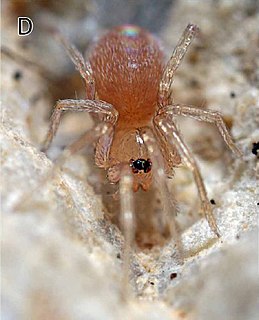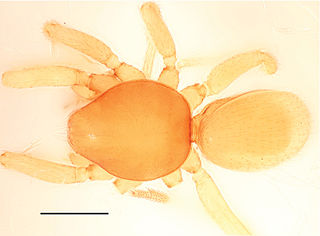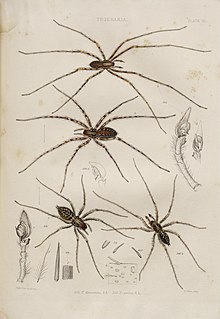
Oonopidae, also known as goblin spiders, is a family of spiders consisting of over 1,600 described species in about 113 genera worldwide, with total species diversity estimated at 2000 to 2500 species. The type genus of the family is OonopsKeyserling, 1835.

Norman Ira Platnick was an American biological systematist and arachnologist. At the time of his death, he was a Professor Emeritus of the Richard Gilder Graduate School and Peter J. Solomon Family Curator Emeritus of the invertebrate zoology department of the American Museum of Natural History. A 1973 Ph.D. recipient at Harvard University, Platnick described over 1,800 species of spiders from around the world, making him the second most prolific spider taxonomist in history, behind only Eugène Simon. Until 2014 he was also the maintainer of the World Spider Catalog, a website formerly hosted by the AMNH which tracks the arachnology literature, and attempts to maintain a comprehensive list, sorted taxonomically, of every species of spider which has been formally described. In 2007 he received the International Society of Arachnology's Bonnet award, named for Pierre Bonnet, in recognition of his work on the catalog.

Unicorn ("one horn", in Latin) is a genus of goblin spiders from South America, containing seven species that occur predominantly in high elevation, semi-desert regions of Bolivia, Chile, and Argentina. Individuals are relatively large for goblin spiders, measuring up to 3.0 mm (0.12 in) in body length. The genus name refers to a characteristic pointed projection between the eyes and jaws of males. In at least one species, broken-off tips of the male pedipalps have been found within the genitalia of females, postulated as a means of sperm competition. Unicorn possesses several traits that suggest it is a relatively "primitive" member of the Oonopidae, and is classified with other similar, soft-bodied goblin spiders in the subfamily Sulsulinae.

Bannana is a genus of goblin spiders native to Xishuangbanna prefecture, Yunnan Province, China, where it lives in the leaf-litter of tropical rainforest. There are two known species: Bannana crassispina and B. parvula, both described in 2015. Individuals are pale yellow and unpatterned, and range from around 1.0 to 1.8 mm in body length, with females being slightly larger than males. The eyes are reduced or entirely absent. Known only from a nature reserve in Xishuangbanna, Bannana belongs to a group of Asian goblin spiders known as the "Dysderoides complex", that ranges from China to Pakistan and south to Indonesia.

Eratigena is a genus of spider in the family Agelenidae. Most of its species were moved from the genus Tegenaria in 2013. Two species that frequently build webs in and around human dwellings are now placed in this genus. Eratigena agrestis is the hobo spider, native to Europe and Central Asia, introduced to North America. Eratigena atrica is the giant house spider, native to Europe and also introduced into North America.
Aterigena is a genus of funnel weavers first described by A. Bolzern, A. Hänggi & D. Burckhardt in 2010. The name is an anagram of Tegenaria. It was created in 2010 for a group of Tegenaria and Malthonica species that formed a clade in a phylogenetic analysis. The genus was later found to be monophyletic, further separating Eratigena from Tegenaria and Malthonica.
Aposphragisma is a genus of spiders in the family Oonopidae. It was first described in 2014 by Thoma. As of 2017, it contains 19 species, most found in Malaysia, Borneo, and other Asian nations.
Dysderoides is a genus of spiders in the family Oonopidae. It was first described in 1946 by Fage. As of 2017, it contains 6 species, found in Thailand and India.
Farqua is a genus of spiders in the family Oonopidae. It was first described in 2001 by Saaristo. As of 2017, it contains only one species, Farqua quadrimaculata, from the Farquhar Group islands of the Seychelles.
Hytanis is a genus of spiders in the family Oonopidae. It was first described in 1893 by Simon. As of 2017, it contains only one species, Hytanis oblonga, found in Venezuela.
Sulsula is a genus of spiders in the family Oonopidae. It was first described in 1882 by Simon. As of 2017, it contains only one species, Sulsula pauper, found in Algeria, Egypt, and Sudan.
Varioonops is a genus of goblin spiders that was first described by A. Bolzern & Norman I. Platnick in 2013.
Bipoonops is a genus of spiders in the family Oonopidae. It was first described in 2014 by Bolzern. As of 2016, it contains 3 species, all from Ecuador.
Himalayana is a genus of spiders in the family Oonopidae. It was first described in 2014 by Grismado. As of 2017, it contains 6 species from India and Nepal.
Simlops is a genus of spiders in the family Oonopidae. It was first described in 2014 by Bonaldo, Ott & Ruiz. As of 2017, it contains 15 species.
Emboonops is a genus of spiders in the family Oonopidae. It was first described in 2015 by Bolzern, Platnick & Berniker. As of 2017, it contains 10 species, all from Mexico.
Guatemoonops is a genus of spiders in the family Oonopidae. It was first described in 2015 by Bolzern, Platnick & Berniker. As of 2017, it contains 6 species, from Guatemala and Mexico.
Khamiscar is a genus of spiders in the family Oonopidae. It was first described in 2015 by Platnick & Berniker. As of 2017, it contains 6 species, all found in Madagascar.
Toloonops is a genus of spiders in the family Oonopidae. It was first described in 2015 by Bolzern, Platnick & Berniker. As of 2017, it contains 7 species.

Eratigena duellica, the giant house spider, is a species of funnel weaver in the spider family Agelenidae. It is found in Canada, the United States, and Europe. The related species Eratigena atrica is also called the Giant house spider.





